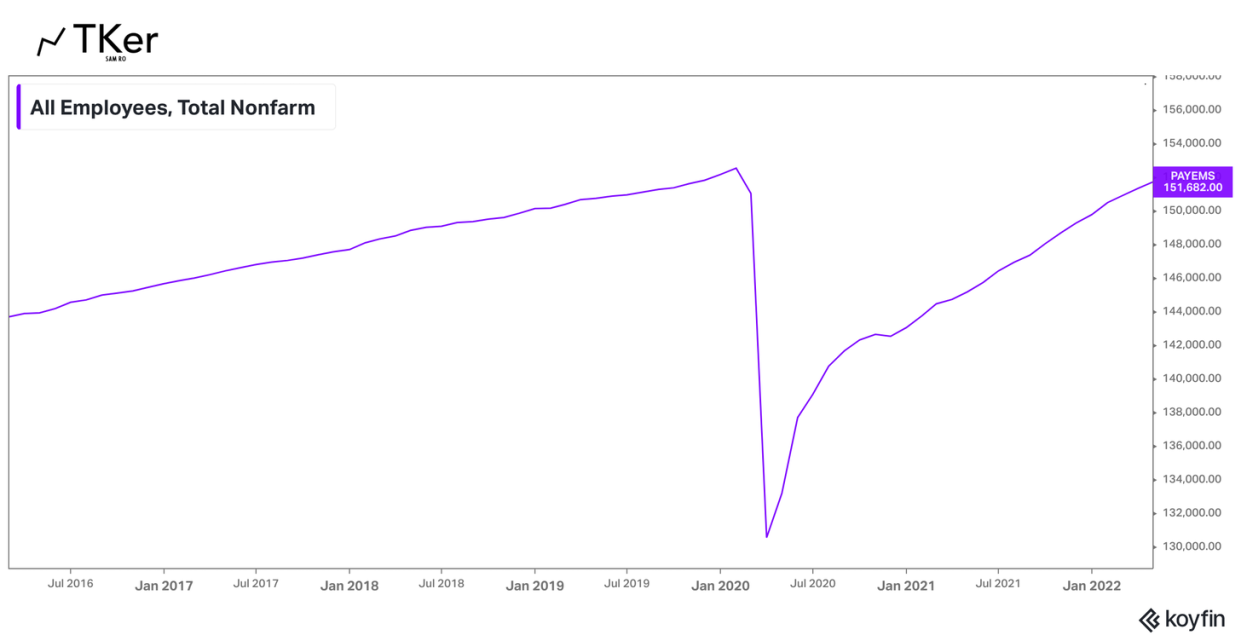The 'too hot' jobs market has gotten a little more 'just right'
This post was originally published on Tker.co.
In recent weeks, we’ve watched evidence accumulate suggesting that the economic narrative is shifting toward one in which growth cools from very hot levels — but not by so much that the economy spirals into a recession.
The May U.S. jobs report released Friday provided more confirmation of this shift.
According to the report, U.S. employers added a healthy 390,000 jobs in May. This was down from the 436,000 jobs added in May but still stronger than the 318,000 gain that economists expected.¹
The unemployment rate was unchanged at a very low 3.6%², though it’s worth noting that the labor force participation improved to 62.3% as 330,000 people entered the labor force.³

Average hourly earnings in May, meanwhile, increased by 0.3% from April, reflecting a 5.2% gain from a year ago. However, this is down slightly from the 5.5% annual growth rate in April and the 5.6% rate in May.
In summary, the U.S continues to put people back to work, which is good news for economic growth. The pace of job growth may be cooling, but employers seem to be attracting people back into the labor force without causing wage growth to accelerate, which is good news for those looking to bring inflation down.

This is exactly the kind of balance the Federal Reserve is hoping for as it continues to tighten monetary policy in its efforts to cool inflation from very high levels.
Here’s some of what Wall Street’s top economists said following Friday’s report:
“It appears that we are past the peak in wage inflation.“ - Stephen Juneau, U.S. economist at Bank of America“Simply put, there’s a good chance that wage growth is past its cyclical peak and a cooling trend is underway.“ - Bob Schwartz, senior economist at Oxford Economics“Today's report lands in a sweet spot for the Fed.“ - Sarah House, senior economist at Wells Fargo“For the Fed, today’s report is probably about the best they could hope for in the early innings of the tightening cycle.“ - Michael Feroli, chief U.S. economist at JPMorgan“The deceleration in wage growth is encouraging because it suggests that the broader cyclical price pressures in the economy are close to peaking. But it will take a slowdown in annual wage growth to closer to 4% before the Fed can claim it is making significant progress towards its inflation goal.“ - Michael Pearce, senior U.S. economist at Capital Economics“In short, the May report supports the view that while the labor market remains firm, it continues to gradually slow.“ - Oscar Munoz, macro strategist at TD Securities“Admittedly we do expect to see slower payrolls growth in coming month, but this should not come as a huge surprise given that 21.2mn of the 22mn jobs lost in March and April 2020 have now been filled.“ - James Knightley, chief international economist at ING“This is a watershed moment for the trajectory of payrolls and now directly places the spotlight on how deep this turn will be.” - Rick Rieder, CIO of global fixed income at BlackRock
It may seem odd to be celebrating a slowdown in wage growth. But high wage growth amid tight supply is part of the reason we have high inflation. And wage growth isn’t worth much if inflation is eating away at your spending power. This is why good news is bad news these days.
More signs that the labor market is inflecting
For almost two years, we’ve been hearing about intensifying labor shortages across industries as millions of jobs — and counting — have gone unfilled, a challenge that has caused wages to surge, which in turn has been pushing inflation higher for goods and services.
But in recent weeks, we’ve been getting signs that the labor market could be at an inflection point.
Here are some of the datapoints:
Job openings ticked lower to 11.4 million in April from a record-high 11.9 million in March.
There were 1.92 job openings per unemployed person in April, down marginally from a record high of 1.99 in March.
Labor market sentiment — as measured by the labor market differential — recently fell to its lowest level since May 2021.
Private payrolls in May grew at its slowest pace since April 2020, according to payroll processing firm ADP.
Initial claims for unemployment insurance came in at 200,000 for the week ending May 28, which is still below pre-pandemic levels but up from its six-decade low of 166,000 in March.
The ISM manufacturing survey’s employment index fell to 49.6 in May, signaling contraction in factory jobs. It was the lowest print since November 2020.
None of this screams recession, especially with layoffs at record lows. But taken together, it appears that the labor market is a little less hot than it was earlier this year and people are picking up on it.
And the fact that this cooling has so far come without a material spike in the unemployment rate will be welcome news for the Fed as it maneuvers to bring down inflation.
That said, inflation data will be watched extremely closely in the coming months. Because keep in mind: The Fed’s ultimate goal isn’t to just slow the economy. Its ultimate goal is to cool inflation. Using policy tools to slow the economy is just a means to achieve those ends.
—
Related from TKer:
Rearview 🪞
📉 Stocks fall: The S&P 500 fell 1.2% last week. The index is now down 14.3% from its January 3 closing high of 4796.56, but 5.3% above its May 19 closing low of 3,900.79. For more on market volatility, read this and this. If you wanna read up on bear markets, read this.

🌀 Bankers talk “hurricanes”: America’s top bankers used some colorful metaphors this week to describe the state of risk in the economy. Here’s JPMorgan Chase CEO Jamie Dimon (via The Transcript): “Right now, it's kind of sunny. Things are doing fine. Everyone thinks the Fed can handle this. That hurricane is right out there down the road coming our way. We just don't know if it's a minor one or Superstorm Sandy… You better brace yourself.“
And here’s Bank of America CEO Brian Moynihan (via The Transcript): “We're in North Carolina. You've got hurricanes that come every year. So we're always prepared for if we don't have a choice.“
🤔 I like Moynihan’s characterization a little better because the truth is that there are always economic risks lingering and things could certainly go wrong in the near term. And they often do! Which is why it’s always good to be prepared. But it’s also good to be prepared knowing that things almost always work out for the better in the long run.
💾 Microsoft’s softer outlook: In a regulatory filing Thursday, Microsoft lowered its guidance for revenue and earnings in the current quarter “due to unfavorable foreign exchange rate movement in the quarter through May.“
🚨 It’s possible we see more warnings like Microsoft’s in the weeks to come because as S&P 500 companies generate about 40% of their revenue from outside of the U.S., according to FactSet. And the U.S. dollar has strengthened considerably this year, which means the value of sales generated abroad has been declining.

💰 That said, analysts continue to expect healthy earnings growth for 2022 and 2023.

🛠 Manufacturing picks up: According to the Institute of Supply Management (ISM), manufacturing activity accelerated in May: “Manufacturing performed well for the 24th straight month, with demand registering faster month-over-month growth and consumption softening due to labor force constraints,” Timothy Fiore, chair of the ISM Manufacturing Business Survey Committee, said on Wednesday. “Overseas partners’ disruptions are beginning to impact U.S. manufacturing, creating a near-term headwind for factory output growth. Ten percent of panelists’ general comments expressed difficulty obtaining material from their Asian partners, which will impact reliable deliveries in the summer months.” For more on manufacturing, read this.
😭 Consumer confidence is down: The Conference Board’s Consumer Confidence Index fell to 106.4 in May from 108.6 in April: “Purchasing intentions for cars, homes, major appliances, and more all cooled—likely a reflection of rising interest rates and consumers pivoting from big-ticket items to spending on services,“ The Conference Board’s Lynn Franco said. “Vacation plans have also softened due to rising prices. Indeed, inflation remains top of mind for consumers, with their inflation expectations in May virtually unchanged from April’s elevated levels. Looking ahead, expect surging prices and additional interest rate hikes to pose continued downside risks to consumer spending this year.”
Keep in mind that weak consumer confidence does not necessarily mean consumer spending is falling. For more on this, read this and this.

🏘 Home prices are up: U.S. home prices in March jumped 20.6% from a year ago, according to the S&P CoreLogic Case-Shiller Index. That's the third highest reading in the index’s history. From S&P DJI’s Craig Lazzara: “Those of us who have been anticipating a deceleration in the growth rate of U.S. home prices will have to wait at least a month longer... Mortgages are becoming more expensive as the Federal Reserve has begun to ratchet up interest rates, suggesting that the macroeconomic environment may not support extraordinary home price growth for much longer. Although one can safely predict that price gains will begin to decelerate, the timing of the deceleration is a more difficult call.“

Up the road 🛣
These days, no economic metric is more important than inflation. Friday comes with the May consumer price index (CPI) report. Economists estimate that CPI climbed 0.7% from April, reflecting an 8.2% gain from a year ago. Excluding food and energy prices, core CPI is estimated to have increased by 0.4% month-over-month or 5.9% year-over year. Will the report confirm that peak inflation is behind us?

—
¹There are have been 2.34 million jobs created so far in 2022. It’s one of the more convincing stats that the U.S. economy has not been drifting toward a recession.

²The unemployment rate is currently at its lowest level since the pandemic began. Prior to the pandemic, the unemployment rate was as low as 3.5% in January and February 2020.

³The civilian labor force consists of adults with jobs or actively seeking jobs. The labor force participation rate represents the civilian labor force as a percentage of the adult population. One of the reasons there continues to be 11 million job openings is because the labor force participation rate has not yet returned to pre-pandemic levels. You can read more about that here.

This post was originally published on Tker.co.
Sam Ro is the founder of Tk.co. Follow him on Twitter at @SamRo
Follow Yahoo Finance on Twitter, Facebook, Instagram, Flipboard, LinkedIn, and YouTube
